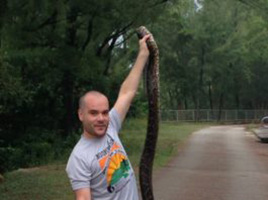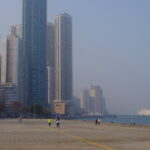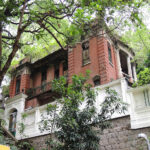There are around 55 snake species around Hong Kong, not including the six species of sea snake that are mostly absent from our seas nowadays. Although venomous snakes are common in all 24 of Hong Kong’s country parks (including Tai Tam, Shek O and Pokfulam), the last recorded snakebite death in Hong Kong occurred over 20 years ago. Here’s a list of the most common snakes in Hong Kong and what to do if you encounter them.
Burmese Python
Scientific name: python bivittatus
Venomous: no
Appearance: yellow with large brown spots
Size: average 3-4m, maximum size in Hong Kong is 5m
Habitat: shrubland, woodland and mangrove swamps
The Burmese Python is Hong Kong’s largest snake and can be found in a variety of locations, but more commonly in areas of thicker jungle. It typically eats birds and small mammals, but if hungry may attempt larger prey such as dogs, deer or boar. The Burmese Python does not prey on humans, but there have been isolated cases where pythons have bitten passing hikers. The Burmese Python is a protected species in Hong Kong and interfering with or killing one may result in a fine and/or imprisonment.
Chinese Cobra
Scientific name: naja atra
Venomous: yes
Appearance: hooded with a distinct white marking (usually a monocle shape) on its neck. Black but sometimes grey or, in rarer cases, light brown.
Size: average 1.1m
Habitat: grassland, shrubland, woodland, mangrove swamps
Indo Chinese Ratsnake
Scientific name: ptyas korros
Venomous: Non Venomous
Appearance: olive-brown with a long tail and large eyes
Size: average 1.2-1.5m (can reach nearly 2m)
Habitat: found in open, low lying areas such as grassy banks of streams and reservoirs, edges of cultivated fields and ponds, dry shrubland and woodland.
The Indo Chinese Ratsnake is a very common snake and feeds largely on frogs, but also rodents and lizards. It is most active during the daytime and common throughout Hong Kong, including many islands. This species of snake is very fast and will usually dart off if approached unless it is agitated, in which case it will bite quickly and vigorously. It’s commonly sold in snake shops for its gall bladder and meat and, as a result, is considered endangered in China.
Greater Green
Scientific name: cyclophiops major
Venomous: no
Appearance: bright green, often mistaken for the Bamboo Snake.
Size: average 75-90cm, sometimes up to 120cm
Habitat: humid forests, shrubland, woodland, grassland
The Greater Green eats mainly earthworms, insect larvae, and other soft-bodied invertebrates. It’s mild-mannered and rarely bites, moving slowly unless alarmed. It’s common throughout Hong Kong.
King Cobra
Scientific name: ophiophagus hannah
Venomous: yes
Appearance: hooded, black with yellow bands (varies by individual and age).
Size: average 4m, can grow up to 6m
Habitat: grassland, shrubland, woodland, mangrove swamps
The King Cobra is the world’s longest venomous snake and can be found throughout the New Territories. It has a toxic venom and can inject large quantities due to its sheer size. The King Cobra is a very shy creature and will avoid humans unless approached whilst guarding its nest of eggs, in which case it may become very defensive. These snakes have caused human fatalities in Hong Kong in the past, but are now very rare (possibly non-existent) on Hong Kong Island.
Bamboo Snake (White-Lipped Pit Viper)
Scientific name: trimeresurus albolabris
Venomous: yes
Appearance: bright green, yellow eyes, with distinctive reddish-brown tail, triangular head
Size: average 50cm, can grow up to 90cm
Habitat: shrubland, grassland
The Bamboo Snake is responsible for over 90 per cent of all snake bites in Hong Kong but with no recorded fatalities. The snake is nocturnal and is an ambush hunter, relying on its camouflage and waiting for unsuspecting prey, which explains why the majority of snake bites come from this species.
Many Banded Krait
Scientific name: bungarus multicinctus
Venomous: yes
Appearance: alternating black and white bands
Size: average 1-1.2m
Habitat: marshland, shrubland, woodland, catch waters
A highly venomous species with a potent neurotoxic venom that targets the nervous system. Bites from the Many Banded Krait may at first be relatively painless, but can develop into critical organ failure if treatment is not sought. The Many Banded Krait has a flexible neck that can twist and bite even when held behind the neck.
Red-necked Keelback
Scientific name: rhabdophis subminiatus helleri
Venomous: yes
Appearance: olive green, with a red patch behind the head
Size: average 1m
Habitat: near streams or locations where their favourite prey (common toad) is common.
One of Hong Kong’s most common venomous snakes, the Red-necked Keelback has a highly toxic venom. However, it lacks true fangs and can only deliver a venomous bite through its enlarged rear teeth which makes envenomation very unlikely (it would bite and hold on for several seconds to produce a venomous bite).
Common Rat Snake (Oriental Rat Snake)
Scientific name: ptyas mucosus
Venomous: no
Appearance: light brown
Size: average 2-2.2m
Habitat: shrubland, grassland, gardens
The largest of Hong Kong’s four ratsnake species (third longest snake overall) and common throughout Hong Kong. The Common Rat snake is very fast, feeds on frogs and mammals and is quick to defend itself when feeling threatened.
Common Blind Snake (Flowerpot Snake)
Scientific name: ramphotyphlops braminus
Venomous: no
Appearance: dark brown or black
Size: average 10cm
Habitat: almost any terrestrial habitat
Possibly Hong Kong’s (and the world’s) most abundant snake. This tiny snake looks similar to an earthworm and often the only way to tell the difference is by the flickering of its tongue. The Common Blind snake is often found burrowed underground. If handled or threatened, it can use its tail to cause a harmless prick.
What should you do if you’re bitten by a snake?
- Remain calm.
- Move away from the snake.
- Make careful note of the snake’s appearance, ideally take a picture if you can.
- Call for emergency help, or if quicker to do so, go directly to the nearest major hospital.
- Remove restrictive jewellery.
- Apply a pressure bandage to the affected area.
- Call 999 (or if nearby, go straight to hospital).







